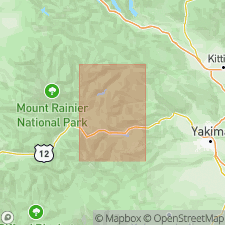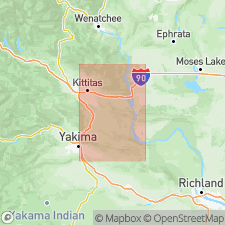
- Usage in publication:
-
- Fifes Peak andesite
- Modifications:
-
- [First used]
- Dominant lithology:
-
- Andesite
- AAPG geologic province:
-
- Eastern Columbia basin
Summary:
Name applied to a unit consisting of basic andesite flows and pyroclastics forming upper part of Keechelus andesitic series in Mount Aix quadrangle. Unconformable on lower part of Keechelus series. Overlapped by marginal flows of Yakima basalt. Age is Oligocene or Miocene.
[Type lcoality not stated.] Occurs in Mount Aix quadrangle in vicinity of Fifes Peak, Yakima Co., south-central WA.
Source: US geologic names lexicon (USGS Bull. 1200, p. 1346).

- Usage in publication:
-
- Fifes Peak andesite
- Modifications:
-
- Original reference
- Dominant lithology:
-
- Flows
- Agglomerates
- Tuffs
- AAPG geologic province:
-
- Eastern Columbia basin
Summary:
Pg. 800-802. Fifes Peak andesite. Described as a group of flows, agglomerates, and tuffs. Proportion of flows to agglomerates and tuffs varies from place to place; on the whole, the pyroclastic materials have the greater volume. Flows are black on fresh exposures; they are dense to vitreous, porphyritic, with clear phenocrysts of plagioclase. On weathered surfaces, rock is brownish with chalky phenocrysts. Tuffs are yellow to buff. Agglomerates are variable in color with grays, reds, and purples predominating. Underlies Yakima basalt. Presumably not younger than middle Miocene.
[Type lcoality not stated.] Occurs in Mount Aix quadrangle in vicinity of Fifes Peak, Yakima County, south-central WA.
Source: US geologic names lexicon (USGS Bull. 1200, p. 1346).
For more information, please contact Nancy Stamm, Geologic Names Committee Secretary.
Asterisk (*) indicates published by U.S. Geological Survey authors.
"No current usage" (†) implies that a name has been abandoned or has fallen into disuse. Former usage and, if known, replacement name given in parentheses ( ).
Slash (/) indicates name conflicts with nomenclatural guidelines (CSN, 1933; ACSN, 1961, 1970; NACSN, 1983, 2005, 2021). May be explained within brackets ([ ]).

